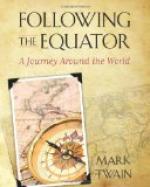And we saw little jade gods, to hang around the neck—not everybody’s, but sacred to the necks of natives of rank. Also jade weapons, and many kinds of jade trinkets—all made out of that excessively hard stone without the help of any tool of iron. And some of these things had small round holes bored through them—nobody knows how it was done; a mystery, a lost art. I think it was said that if you want such a hole bored in a piece of jade now, you must send it to London or Amsterdam where the lapidaries are.
Also we saw a complete skeleton of the giant Moa. It stood ten feet high, and must have been a sight to look at when it was a living bird. It was a kicker, like the ostrich; in fight it did not use its beak, but its foot. It must have been a convincing kind of kick. If a person had his back to the bird and did not see who it was that did it, he would think he had been kicked by a wind-mill.
There must have been a sufficiency of moas in the old forgotten days when his breed walked the earth. His bones are found in vast masses, all crammed together in huge graves. They are not in caves, but in the ground. Nobody knows how they happened to get concentrated there. Mind, they are bones, not fossils. This means that the moa has not been extinct very long. Still, this is the only New Zealand creature which has no mention in that otherwise comprehensive literature, the native legends. This is a significant detail, and is good circumstantial evidence that the moa has been extinct 500 years, since the Maori has himself—by tradition—been in New Zealand since the end of the fifteenth century. He came from an unknown land—the first Maori did—then sailed back in his canoe and brought his tribe, and they removed the aboriginal peoples into the sea and into the ground and took the land. That is the tradition. That that first Maori could come, is understandable, for anybody can come to a place when he isn’t trying to; but how that discoverer found his way back home again without a compass is his secret, and he died with it in him. His language indicates that he came from Polynesia. He told where he came from, but he couldn’t spell well, so one can’t find the place on the map, because people who could spell better than he could, spelt the resemblance all out of it when they made the map. However, it is better to have a map that is spelt right than one that has information in it.
In New Zealand women have the right to vote for members of the legislature, but they cannot be members themselves. The law extending the suffrage to them event into effect in 1893. The population of Christchurch (census of 1891) was 31,454. The first election under the law was held in November of that year. Number of men who voted, 6,313; number of women who voted, 5,989. These figures ought to convince us that women are not as indifferent about politics as some people would have us believe. In New Zealand as a whole, the estimated adult female population was 139,915; of these 109,461 qualified and registered their names on the rolls 78.23 per cent. of the whole. Of these, 90,290 went to the polls and voted—85.18 per cent. Do men ever turn out better than that—in America or elsewhere? Here is a remark to the other sex’s credit, too—I take it from the official report:




